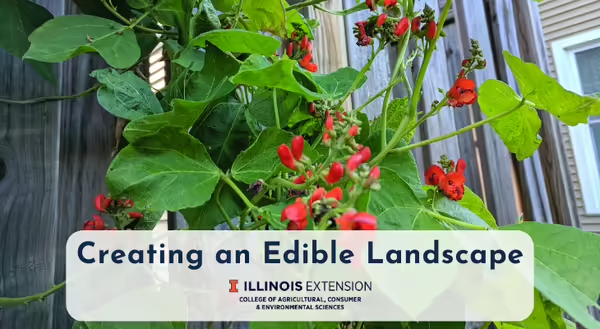
When we think of the typical home landscape, our garden areas are usually separated by the type of plant being grown. We have a separate bed for flowers and ornamental plants, one for vegetables and one for herbs. Often the vegetable and herb gardens are tucked away in the backyard and out of view from the neighbors. However, in recent years there has been an increasing trend to incorporate edible food crops into landscapes or edible landscaping.
Edible landscaping is the use of food-producing plants in landscapes. It combines fruit and nut trees, berry bushes, vegetables, herbs, edible flowers, along with ornamental plants. Many of our edible plants can be just as attractive as our ornamental plants, but with the added benefit of producing food (dual-purpose plants).
Just like planning any other landscape, make sure you start with a plan when incorporating edibles into your landscape. Keep in mind that most fruits and vegetables require full sun conditions, although some of the leafy greens like lettuce and kale can tolerate more shade. Like selecting any other plant for your landscape, make sure to keep in mind how large the plant will reach at maturity before placing it into your landscape, this is especially important for perennial plants. Edible plants can also have different care requirements than ornamental plants, especially if we wish to use them for food. So, make sure you familiarize yourself with their care requirement, as well as how and when they should be harvested beforehand.
Fruit trees like apples and peaches can provide beautiful flower displays in the spring as well as fall color in addition to their fruits. Apples are a good option if you have limited space, plants on dwarfing rootstock may only reach 6 to 8 feet in height (they may need support though). Nut trees such as walnuts and pecans can grow to be large trees (50+ feet) and provide shade in addition to nuts (keep in mind it will take several years before you get nuts to harvest).
Edible shrubs such as blueberries, elderberries, and raspberries can be used to create hedges and screens or used as foundation plantings or accent plants. Asparagus plants can also be used to make a hedge, screen a fence, or act as a backdrop for flowers. Edible vining plants such as grapes and hardy kiwi can be utilized to cover fences or arbors. Vegetables like cucumbers, peas, and runner beans can be used in the same way. One landscape plant we commonly used as a shrub or vine, roses, have edible petals. Additionally, some cultivars will produce edible rose hips that can also provide color during the fall and winter.
Strawberries, nasturtium (edible leaves and flowers), and some herbs like mint and thyme can be used as ground covers. Other herbs and vegetables like basil, kale, lettuce, and swiss chard can be utilized for their colorful foliage while the fruit of peppers and eggplants can provide a touch of color. There are also a variety of different types of plants that have edible flowers such as bachelor buttons, borage, calendula, daylilies, lilac, and pansies. Even the dandelions growing in your yard are edible.
These are only a few examples of ways edible crops can be incorporated into landscapes. Regardless of what plants you choose, it’s best to start small and keep your own personal culinary tastes in mind.
Good Growing Tip of the Week: If you are going to be integrating food crops into your landscapes, be careful when using pesticides. Make sure any pesticides you are using are labeled for use on the food crop you’ll be applying them to and follow all pre-harvest intervals.
Want to get notified when new Good Growing posts are available? SIGN UP HERE!